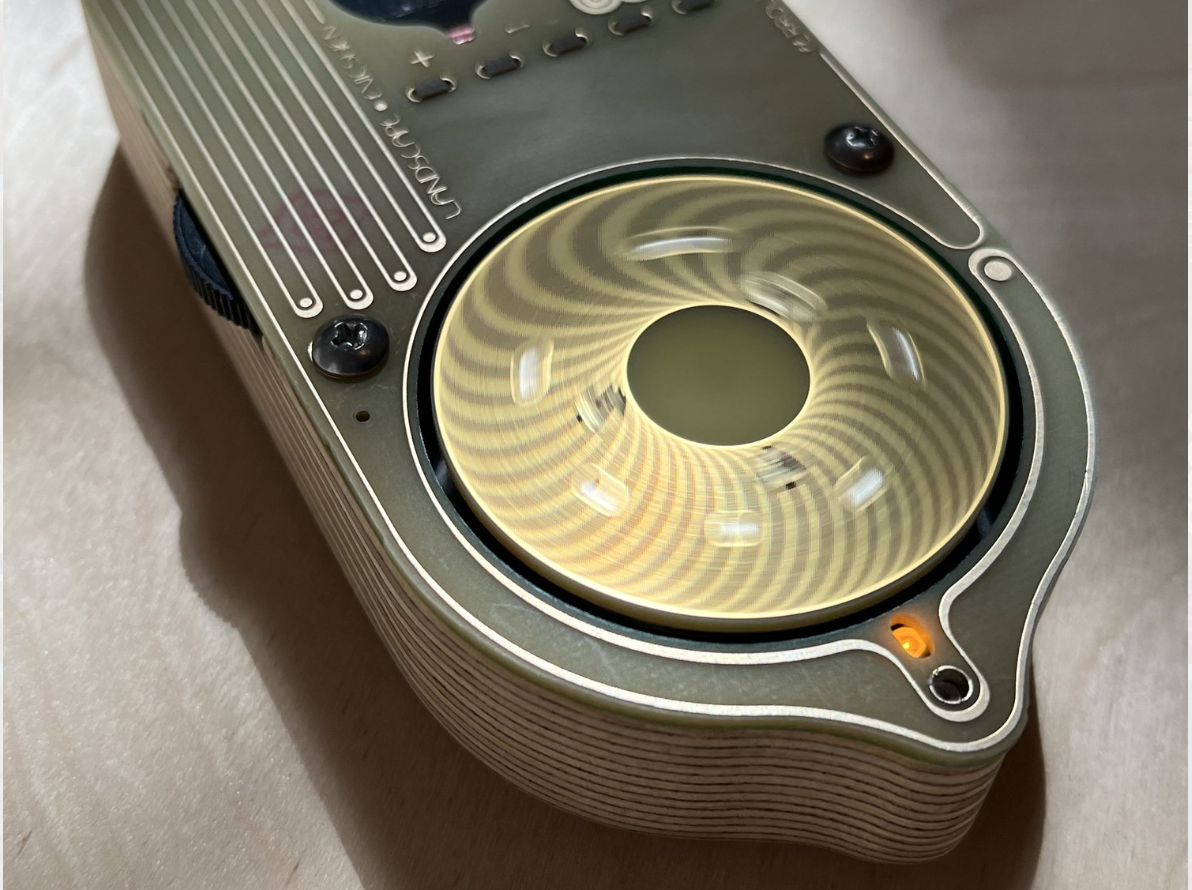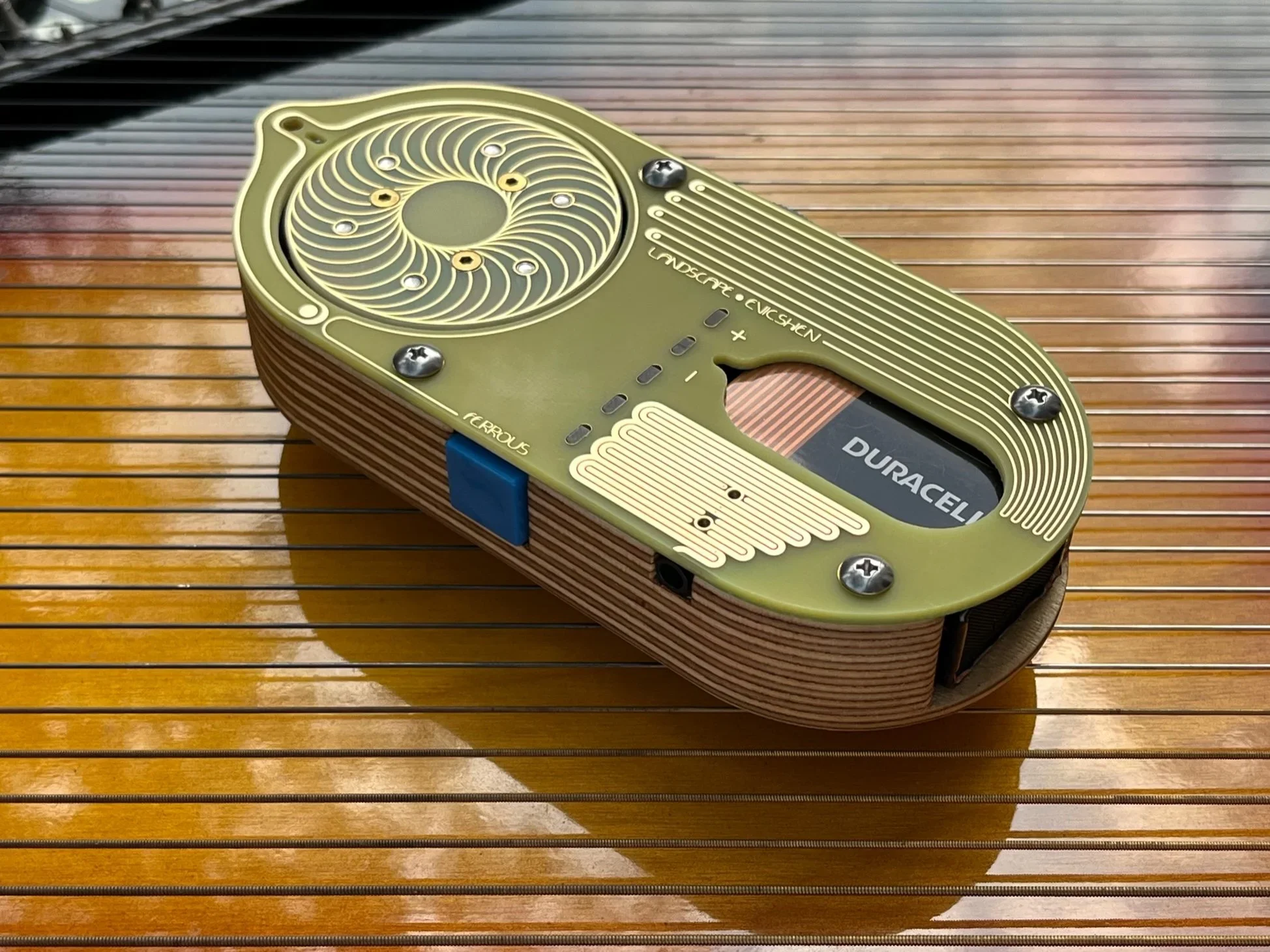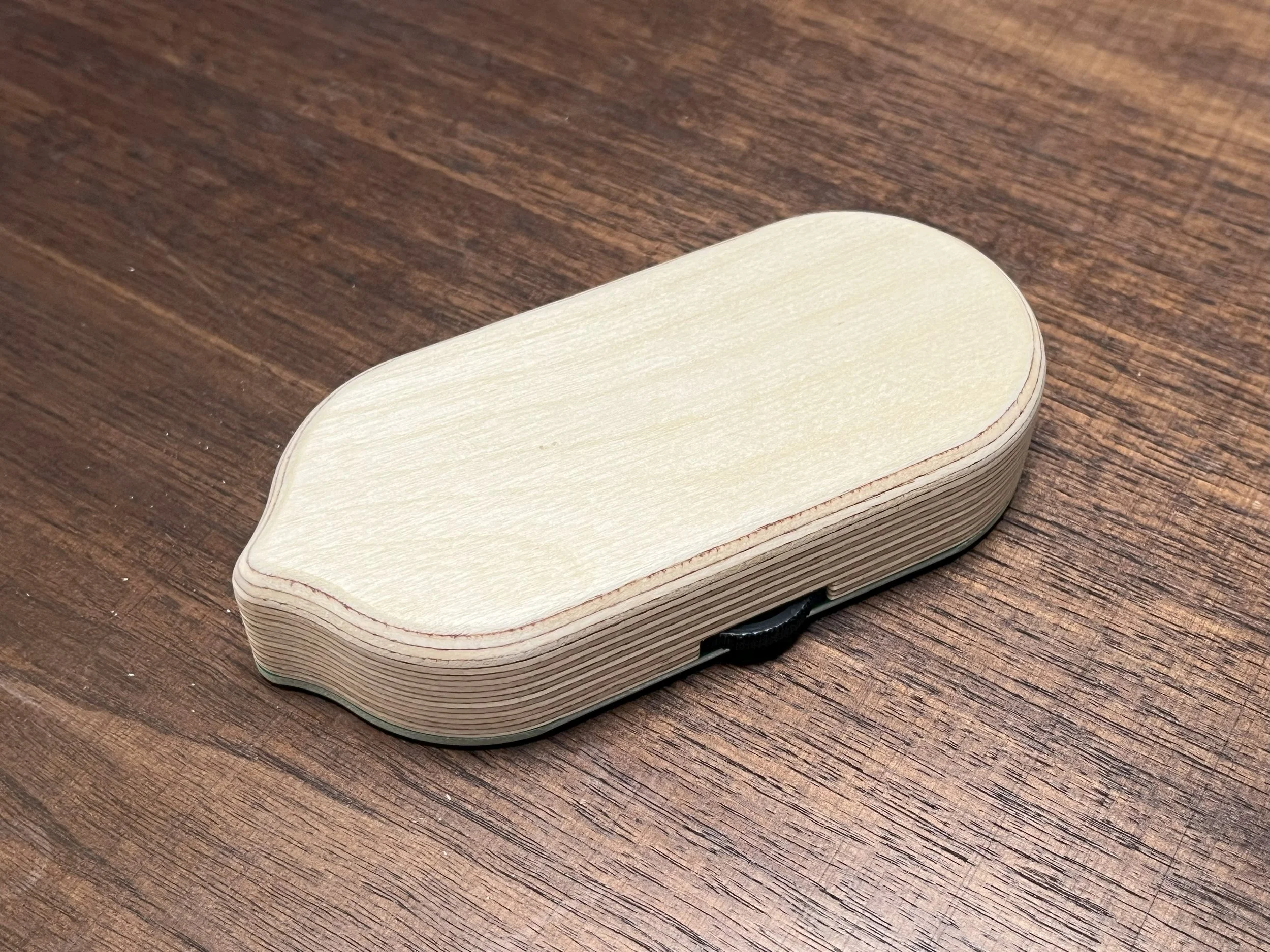FERROUS
Spinning Magnetic Polyphonic String Resonator
A collaboration with Evicshen
Resonate multiple steel strings through magnetic strumming. Hover Ferrous at varying distances above any steel-stringed instrument to create ethereal sounds and floating sine waves. Fluctuate rotation speed by using the thumbwheel, pulse button, touch-plate or control voltage input, creating harmonic changes or a soft strumming effect across strings.
$225
Download Manual | Ships within one week




-
Sine wave-like string resonance & harmonic overtones
Pitch modulation
Pitch bending behavior
Pseudo feedback tonalities
Polyphonic magnetic strumming
Pitch beating between dominant resonant strings and the motor’s speed
Activate higher harmonics and related fundamental pitches simultaneously
Three small magnets provide higher-order harmonics and three larger magnets create lower-order harmonics
Higher RPMs often lead to higher strings resonating and higher harmonic overtones
Lower RPMs often lead to lower strings resonating and less harmonic overtones
-
POWER: Charge the included 9v rechargeable battery for ~1 hour prior to use (the LED on the battery should turn green or blue). If the battery does not charge, try a different USB power source (computer USB port or wall USB charger). To insert the battery, turn Ferrous so the wheel faces the floor; insert the battery with the ± terminals aligned to the ± on the faceplate and push it gently until it clicks into the terminal. To remove the battery, locate the small divot between the +/- symbols; then using the tip of a pen or a small screw driver, gently pry the battery outwards. You can use your thumbs to slide it the rest of the way out.
ACTIVATE: Turn the black thumbwheel (listen for the click). The yellow LED will turn on and the disc will begin spinning. Feel how the thumbwheel control changes the speed of the disc and how the blue Pulse button “pulses” the RPM faster.
HOVER: Hold Ferrous about 1/2” (1.3cm) from the steel strings while the disc is spinning. The disc is designed to hover very close above the strings without touching them. Move closer or further away to adjust volume/resonant strength. When placed close to the strings, strong activation can result in strings colliding with the fret board or the spinning disc. It can take some time to get used to placement, distance, holding methods and how your instrument and chord changes interact with the speed of the disc. After you familiarize yourself with this interplay, the results will be much more immediately responsive. If the disc doesn’t spin, test the unit with a regular Alkaline 9v battery, in case of faulty rechargeable battery. Be careful never to touch the magnetic disc directly to electric guitar pickups. You could potentially de-magnetize them!
ADJUST: While using Ferrous to search for new harmonic interactions you’ll notice how sensitive the interplay can be between disc RPM and strings/notes. Every time you change the RPM on Ferrous or change a note or chord on an instrument, the resulting interaction has shifted. Interesting interactions can be found by very small speed adjustments with the thumbwheel and/or distance.
PULSE: Pulse speed from low to high to magnetically strum multiple strings. Press the blue Pulse Button, the Touchplate, the Thumbwheel, or the Control Voltage Input. Try shorter and longer taps for different results.
ACCESSORIZE: Use the threaded standoff (with rubber tip) as a rest between strings on a guitar fretboard for more relaxed and controlled playback. To attach, thread the standoff into the hole on the nose of the Ferrous. Try using the rubber bumpers for many-stringed instruments. Unscrewing one screw at a time, place through bumper, and gently repeat 4 times making sure to secure each screw before moving onto the next. Place the bumpered Ferrous atop a stringed instrument, making sure the bumpers are resting on the strings.
EXPERIMENT: See tips & tricks.
-
Ferrous' disc can move at very fast RPM. Be careful of impacting the disc on objects that could be brittle.
Do not use the disc to “grind” objects as you could risk both burning out the motor and destroying the disc.
The disc has a textured design so be careful to not touch with fingernails or any item that could be scratched or damaged.
Some guitar pickups (humbuckers for example) have lots of metal on them which could cause the disc to be magnetically pulled and impact the pickup, this could damage or demagnetize the pickup! Take caution. Never touch Ferrous to any type of wound pickup.
To clean Ferrous, use a dry cotton cloth.
If Ferrous variable speed options are not working, clean the touch plates with your thumb or a dry cloth.
It takes about 1.5 hours to fully charge the battery. Usually, if the wheel is not spinning, it's a battery issue. Please try to fully recharge the battery, which sometimes means switching from a USB-C cable connected to a computer to a USB-C wall charger, or vice versa. If that doesn’t work, please try a different 9-volt battery. There are rare occasions when the battery is bad and needs to be swapped out.
-
Dimensions: 13.3 x 6.4 x 2.5 cm / 5.25” x 2.5” x 1”
Weight: 0.15 kg / 0.4 lbs
Materials: Birch plywood enclosure + PCB/Fiberglass interface and disc + neodymium magnets + repurposed hard drive motor + negative space cutouts for exposed battery access.
Controls: Thumbwheel for speed adjustment (+ on/off). Pushbutton for momentary full speed RPM or pulse. Touch-plate for pressure sensitive speed control. Control Voltage input for external speed control.
Power: 9v Battery - Ferrous ships with a rechargeable 9v battery. The (mini)USB charging port is left exposed so you don’t have to remove the battery during charging. Some 9v batteries (9v carbon zinc & those that are less than 1300mAh, for example) may not be able to provide enough power to properly power the brushless motor.
Assist 1: A provided threaded standoff with rubber tip can be added near the LED as a fretboard rest between strings.
Assist 2: Four small rubber feet (provided) can be added to the four provided screws using a phillips head screwdriver, so the Ferrous can rest on strings.
-
Acoustic Bass
Acoustic Guitar
Auto-harp
Baglama
Banjo
Cello
Double Bass
Electric Bass
Electric Guitar
Harp
Kalimba
Mandolin
Pedal Steel
Piano
Psaltery
Resonant Steel/Iron everyday objects
Resonant Non-steel objects, when used with earth magnets attached to or sandwiching said objects
Sitar
Swarmandal
Urhu
Veena
Violin
Zither
Other instruments with steel strings not yet tested
*All instruments listed above must be of the steel string variety
-
IRON CONTENT: The results between instrument to instrument will be different based on specifics like string thickness and string iron content. The more iron the better! Some cello and violin strings have low iron content, so less movement.
STABILIZATION: When Ferrous is held close to the strings of an instrument you will feel the strong magnetic pull. Try to avoid contact between the disc and strings through practice and use of the provided accessories.
PITCH ALIGNMENT: As the disc speed comes into alignment with the resonance of surrounding strings, you will sometimes hear two pitches beating against one another before sliding/bending into place, resulting finally in a swell in volume and greater string vibration. This can be happening to multiple strings simultaneously.
GUITAR: By holding Ferrous 90° to the neck of a guitar, you can use your ring finger and pinky to modulate speed with the touch-plate below. To do this, set the RPM slow. Additionally, one stabilization method for guitar is to rest the thumb and pointer finger on the outside edges of the fretboard. This acts as a way to ensure proper distance between the strings and rotating disc.
ELECTRIC GUITAR OR BASS: When using Ferrous with an electric guitar (or other instrument with pickups) the preferred placement is above the fretboard. Keep the rotating disc at least 5” away from magnetic pickups to ensure less of the motor sound mixing with the resonating string sound (unless this is a desired effect). If Ferrous is placed near guitar pickups you will hear the heavy sounds of spinning magnets and the motor with the resulting pitch based upon the disc’s RPM. Hold Ferrous near (but don’t touch them!) magnetic pickups to hear bass-heavy distorted beating of the magnets rotating. **Never touch magnetic disc directly to pickups because this can damage/de-magnetize them!
PIANO: When using Ferrous with exposed piano strings, the magnetic pull can cause the rotating disc to come into contact with the strings causing a loud buzz. This can also happen when the resonance builds to such a degree that the strings vibrate far outside of their normal bounds and contact the underside of the Ferrous. A helpful method for stabilizing height is to slightly protrude the thumb and pointer finger past the flat bottom surface of Ferrous and rest them on the surrounding strings. A better method is to use the included rubber bumpers. To attach them, remove the four silver screws and place the rubber feet over the holes with the "cups" facing upwards, one at a time.
CONTROL VOLTAGE: Place the bumpered Ferrous atop a stringed instrument (making sure the bumpers are on the strings) and plug in a control voltage (0-9v) to control the speed with a voltage sequencer, for example. You will hear the slew (ramping up and down) of the RPM when there are changes in voltage between steps. It could be useful to start with a slower BPM on your sequencer or modulation source until you get a feel for interaction. Interesting results can be had with large or small jumps in voltage. Results depend on many variables, like what instrument is being used, how the strings are tuned, how far apart the strings are, etc. It can be fun to use a keyboard that sends CV to play the notes and harmonics. To do so, search for the notes on the keyboard that provide interesting interactions. You may hear resonances build and settle into place that sound somewhere between a pitch bend and slow envelope attack.
VANZANDT SANDWICH METHOD: Use eye protection! Take two or more earth magnets and sandwich them around an object that is not easily resonated (a metal table leg, a cardboard box, a cymbal, a lamp shade, an aluminum bowl, a steel tank, etc). Hover Ferrous over the magnet(s). Be careful of touching the disc with the magnets (or any object, for that matter) because it could send debris/particles/magnets flying!
Audio Samples
Squire Super-Sonic recorded directly into mixer (examples with fx are noted).
Sterling Sub 4 recorded directly into mixer.
Weber console piano recorded with one condenser mic.
Video Samples








